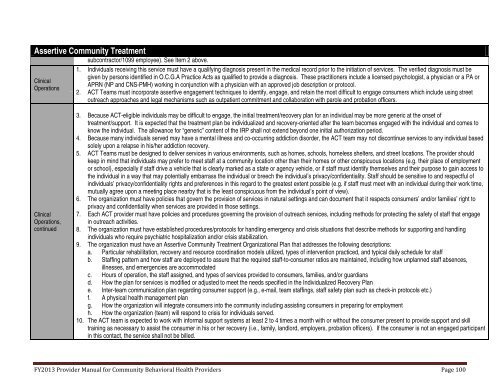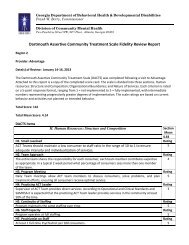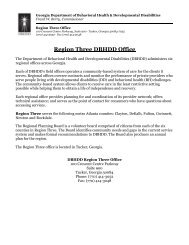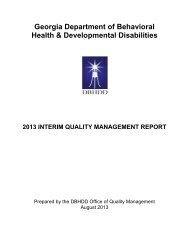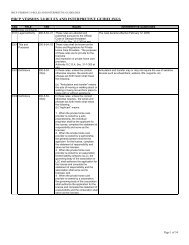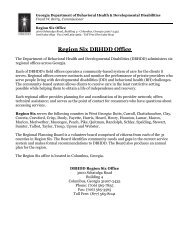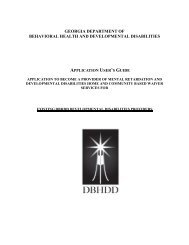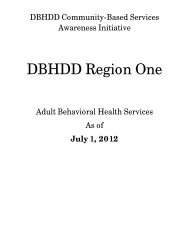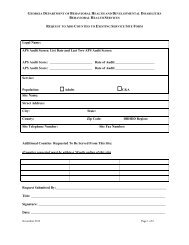PART I - Department of Behavioral Health and Developmental ...
PART I - Department of Behavioral Health and Developmental ...
PART I - Department of Behavioral Health and Developmental ...
You also want an ePaper? Increase the reach of your titles
YUMPU automatically turns print PDFs into web optimized ePapers that Google loves.
Assertive Community Treatmentsubcontractor/1099 employee). See Item 2 above.ClinicalOperations1. Individuals receiving this service must have a qualifying diagnosis present in the medical record prior to the initiation <strong>of</strong> services. The verified diagnosis must begiven by persons identified in O.C.G.A Practice Acts as qualified to provide a diagnosis. These practitioners include a licensed psychologist, a physician or a PA orAPRN (NP <strong>and</strong> CNS-PMH) working in conjunction with a physician with an approved job description or protocol.2. ACT Teams must incorporate assertive engagement techniques to identify, engage, <strong>and</strong> retain the most difficult to engage consumers which include using streetoutreach approaches <strong>and</strong> legal mechanisms such as outpatient commitment <strong>and</strong> collaboration with parole <strong>and</strong> probation <strong>of</strong>ficers.ClinicalOperations,continued3. Because ACT-eligible individuals may be difficult to engage, the initial treatment/recovery plan for an individual may be more generic at the onset <strong>of</strong>treatment/support. It is expected that the treatment plan be individualized <strong>and</strong> recovery-oriented after the team becomes engaged with the individual <strong>and</strong> comes toknow the individual. The allowance for “generic” content <strong>of</strong> the IRP shall not extend beyond one initial authorization period.4. Because many individuals served may have a mental illness <strong>and</strong> co-occurring addiction disorder, the ACT team may not discontinue services to any individual basedsolely upon a relapse in his/her addiction recovery.5. ACT Teams must be designed to deliver services in various environments, such as homes, schools, homeless shelters, <strong>and</strong> street locations. The provider shouldkeep in mind that individuals may prefer to meet staff at a community location other than their homes or other conspicuous locations (e.g. their place <strong>of</strong> employmentor school), especially if staff drive a vehicle that is clearly marked as a state or agency vehicle, or if staff must identify themselves <strong>and</strong> their purpose to gain access tothe individual in a way that may potentially embarrass the individual or breech the individual’s privacy/confidentiality. Staff should be sensitive to <strong>and</strong> respectful <strong>of</strong>individuals’ privacy/confidentiality rights <strong>and</strong> preferences in this regard to the greatest extent possible (e.g. if staff must meet with an individual during their work time,mutually agree upon a meeting place nearby that is the least conspicuous from the individual’s point <strong>of</strong> view).6. The organization must have policies that govern the provision <strong>of</strong> services in natural settings <strong>and</strong> can document that it respects consumers’ <strong>and</strong>/or families’ right toprivacy <strong>and</strong> confidentiality when services are provided in those settings.7. Each ACT provider must have policies <strong>and</strong> procedures governing the provision <strong>of</strong> outreach services, including methods for protecting the safety <strong>of</strong> staff that engagein outreach activities.8. The organization must have established procedures/protocols for h<strong>and</strong>ling emergency <strong>and</strong> crisis situations that describe methods for supporting <strong>and</strong> h<strong>and</strong>lingindividuals who require psychiatric hospitalization <strong>and</strong>/or crisis stabilization.9. The organization must have an Assertive Community Treatment Organizational Plan that addresses the following descriptions:a. Particular rehabilitation, recovery <strong>and</strong> resource coordination models utilized, types <strong>of</strong> intervention practiced, <strong>and</strong> typical daily schedule for staffb. Staffing pattern <strong>and</strong> how staff are deployed to assure that the required staff-to-consumer ratios are maintained, including how unplanned staff absences,illnesses, <strong>and</strong> emergencies are accommodatedc. Hours <strong>of</strong> operation, the staff assigned, <strong>and</strong> types <strong>of</strong> services provided to consumers, families, <strong>and</strong>/or guardiansd. How the plan for services is modified or adjusted to meet the needs specified in the Individualized Recovery Plane. Inter-team communication plan regarding consumer support (e.g., e-mail, team staffings, staff safety plan such as check-in protocols etc.)f. A physical health management plang. How the organization will integrate consumers into the community including assisting consumers in preparing for employmenth. How the organization (team) will respond to crisis for individuals served.10. The ACT team is expected to work with informal support systems at least 2 to 4 times a month with or without the consumer present to provide support <strong>and</strong> skilltraining as necessary to assist the consumer in his or her recovery (i.e., family, l<strong>and</strong>lord, employers, probation <strong>of</strong>ficers). If the consumer is not an engaged participantin this contact, the service shall not be billed.FY2013 Provider Manual for Community <strong>Behavioral</strong> <strong>Health</strong> Providers Page 100


